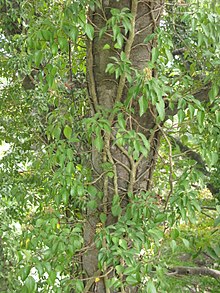Hedera

Hedera, commonly called ivy (plural ivies), is a genus of 12–15 species of evergreen climbing or ground-creeping woody plants in the family Araliaceae, native to western, central and southern Europe, Macaronesia, northwestern Africa and across central-southern Asia east to Japan and Taiwan.
Etymology
The genus name Hedera is the Classical Latin word for ivy, which is cognate with Ancient Greek χανδάνω (khandánō, ‘to get, grasp’), both deriving from Proto-Indo-European *gʰed- (‘to seize, grasp, take’). Hedera may thus be translated as ‘the clinging (plant)’.[2] The modern English ivy derives from Middle English ivi from Old English īfiġ, and ultimately from Proto-Germanic *ibahs. The meaning is uncertain, but the word may be cognate with the Ancient Greek ἴφυον (íphuon) meaning, not Hedera helix, but the unrelated Lavandula spica (lavender).[3]
Description
Hedera helix adult leaves and unripe berries in Ayrshire, Scotland
On level ground they remain creeping, not exceeding 5–20 cm height, but on suitable surfaces for climbing, including trees, natural rock outcrops or man-made structures such as quarry rock faces or built masonry and wooden structures, they can climb to at least 30 m above the ground. Ivies have two leaf types, with palmately lobed juvenile leaves on creeping and climbing stems and unlobed cordate adult leaves on fertile flowering stems exposed to full sun, usually high in the crowns of trees or the tops of rock faces, from 2 m or more above ground. The juvenile and adult shoots also differ, the former being slender, flexible and scrambling or climbing with small aerial roots to affix the shoot to the substrate (rock or tree bark), the latter thicker, self-supporting and without roots. The flowers are greenish-yellow with five small petals; they are produced in umbels in autumn to early winter and are very rich in nectar. The fruit is a greenish-black, dark purple or (rarely) yellow berry 5–10 mm diameter with one to five seeds, ripening in late winter to mid-spring. The seeds are dispersed by birds which eat the berries.
The species differ in detail of the leaf shape and size (particularly of the juvenile leaves) and in the structure of the leaf trichomes, and also in the size and, to a lesser extent, the colour of the flowers and fruit. The chromosome number also differs between species. The basic diploid number is 48, while some are tetraploid with 96, and others hexaploid with 144 and octaploid with 192 chromosomes.[4]
Ecology
Ivies are natives of Eurasia and North Africa but have been introduced to North America and Australia. They invade disturbed forest areas in North America.[5] Ivy seeds are spread by birds.[5]
Ivies are of major ecological importance for their nectar and fruit production, both produced at times of the year when few other nectar or fruit sources are available.[6] The ivy bee Colletes hederae is completely dependent on ivy flowers, timing its entire life cycle around ivy flowering.[7] The fruit are eaten by a range of birds, including thrushes, blackcaps, and woodpigeons.[6] The leaves are eaten by the larvae of some species of Lepidoptera such as angle shades, lesser broad-bordered yellow underwing, scalloped hazel, small angle shades, small dusty wave (which feeds exclusively on ivy), swallow-tailed moth and willow beauty.
A very wide range of invertebrates shelter and overwinter in the dense woody tangle of ivy.[8] Birds and small mammals also nest in ivy.[9] It serves to increase the surface area and complexity of woodland environments.
